Spent a fun day practicing some canoe poling on my local river (Big East, Ontario, Canada). The plan was to pole upstream further than last year's trip , setup a day-camp on a sandy spit somewhere, and snub back down to the launch area. Here's a shot of the gear loaded up at the access point.
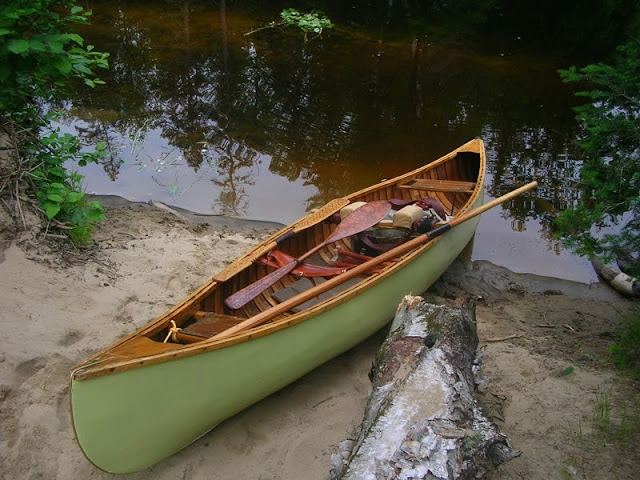
Water levels were much higher than last year's trip when the driest season on record forced a total fireban across much of this part of the province. Surprising how much this changed the nature of the river. Obviously the current was stronger, but this year there were many more downed trees to contend with as well as a lot of channeling where parts of the river had serious flow and others were too shallow to move. Plenty of horizontal trees along the riverbank waiting for their turn to plop down

Horizontal trees on the riverbank
In deeper sections of the river where the canoe pole wasn't needed, I rigged up the camera on the end to record some footage. To secure the pole, the other end was tightly lashed in with the leftover leather straps from the tumpline on the centre thwart. Really like it when gear has more than one usage. Hope this is useful to other solo paddlers wanting to experiment with filming.

Camera secured to top of pole
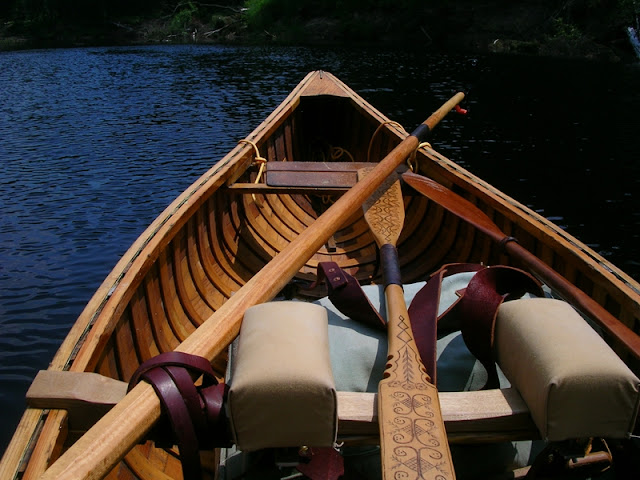
Other end lashed with the excess tumpline straps
Last winter I made a homemade camp stool. I tinkered with the idea of making the legs multi-usage into a homemade camera tripod. Came up with a very crude version, but at least I can justify bringing the campstool and putting it to use when not sitting on it. Here it is in "camera mode". Used this for filming some of the basic shots on shore and for the downstream run.
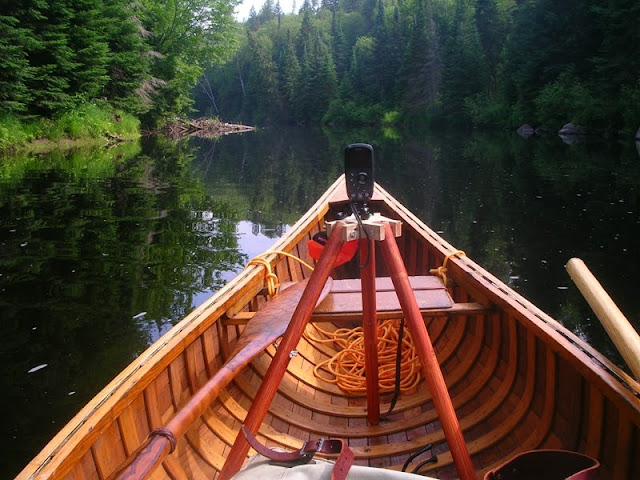
Anyway, after some deep water paddling against the current, the bottom of the river could be seen. At this point, I switched to the much more efficient pole to get further upstream.
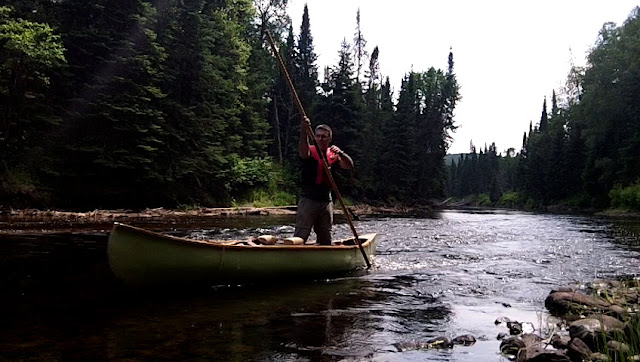
Eventually needed a break to rest up and eat. Spotted this sandy spot which looked perfect to setup a temporary shelter from the sun. The sand was scorching hot! The tripod was reconverted into its "campstool mode" to sit up and enjoy some lunch. If it wasn't so hot, I would've had a fire and cooked up some noodles or something, but a daytime fire in such humid, muggy conditions made no sense.
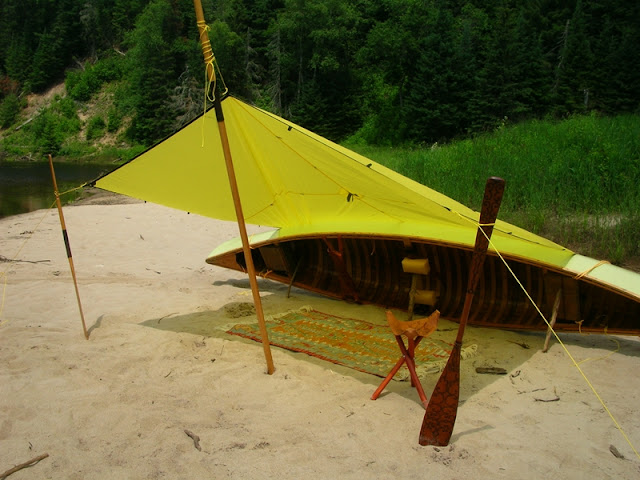
After recharging the inner battery, headed further upstream. As mentioned, the current was much stronger than last year and at one point was too much for a novice poler like myself. After exhausting myself with a few attempts, the only option was to track upstream with painter lines. Rigged up using the bridle system seen in Bill Mason's films and illustrated in Ray Goodwin's great book (see sample pages of this chapter HERE. Found it to be quite tricky work to hold the line angles and not be slipping all over the rocks.
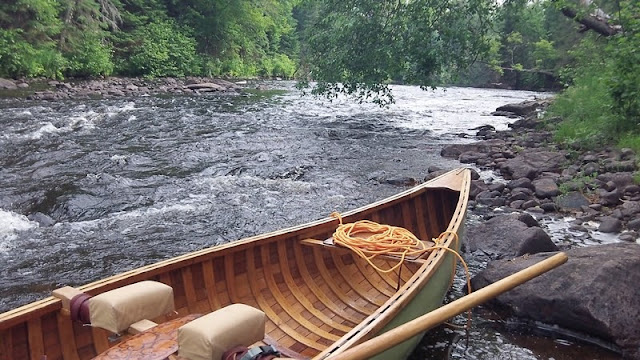
Couldn't pole up this section
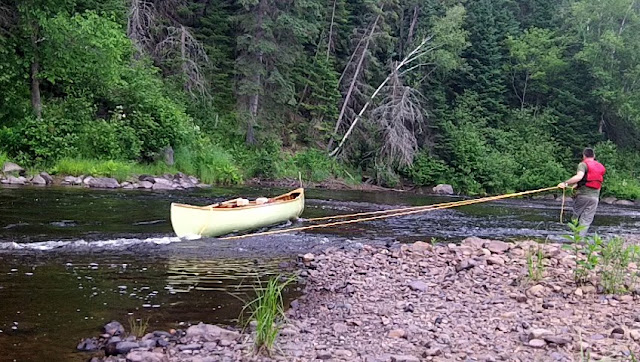
More tracking upstream
Eventually it was time to turn around and head back. Couldn't really manage taking too many pics during the steady downstream run while trying to steer and avoid the fallen debris, but here's a shot in a riffle.

On the way back noticed this adjacent pond off the main river that I didn't catch before. Ended up exploring this neat little section that was free from the current. This is where poling really shines to help get you into these shallow spots

Channel to a little side pond

Poling up the tiny channel
At the far end of the pond was a marshy area where I spotted this guy fishing in the shallows. It allowed me to get a relatively clear shot before retreating in the reeds.
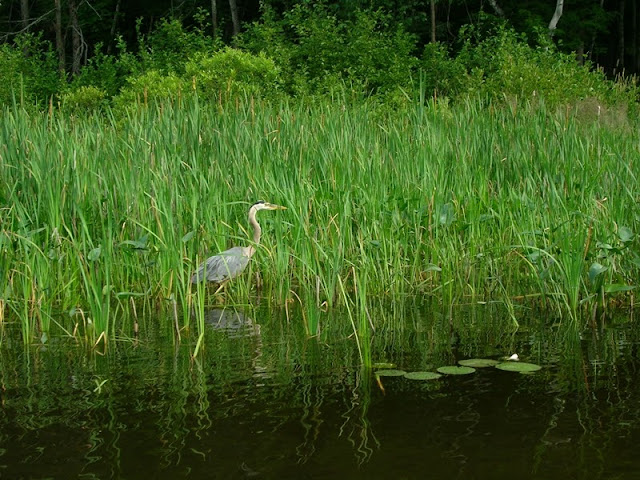
Even though this wasn't really remote trip, I found the different water levels meant that this river was a great place to practice some backcountry skills - paddling, poling, snubbing, lining, & tracking. Put together a brief vid (3:49) of the scenery. Sorry no dramatic music in the background - just the sounds of the river, the bird life, and the deer flies buzzing around.

Water levels were much higher than last year's trip when the driest season on record forced a total fireban across much of this part of the province. Surprising how much this changed the nature of the river. Obviously the current was stronger, but this year there were many more downed trees to contend with as well as a lot of channeling where parts of the river had serious flow and others were too shallow to move. Plenty of horizontal trees along the riverbank waiting for their turn to plop down

Horizontal trees on the riverbank
In deeper sections of the river where the canoe pole wasn't needed, I rigged up the camera on the end to record some footage. To secure the pole, the other end was tightly lashed in with the leftover leather straps from the tumpline on the centre thwart. Really like it when gear has more than one usage. Hope this is useful to other solo paddlers wanting to experiment with filming.

Camera secured to top of pole

Other end lashed with the excess tumpline straps
Last winter I made a homemade camp stool. I tinkered with the idea of making the legs multi-usage into a homemade camera tripod. Came up with a very crude version, but at least I can justify bringing the campstool and putting it to use when not sitting on it. Here it is in "camera mode". Used this for filming some of the basic shots on shore and for the downstream run.

Anyway, after some deep water paddling against the current, the bottom of the river could be seen. At this point, I switched to the much more efficient pole to get further upstream.

Eventually needed a break to rest up and eat. Spotted this sandy spot which looked perfect to setup a temporary shelter from the sun. The sand was scorching hot! The tripod was reconverted into its "campstool mode" to sit up and enjoy some lunch. If it wasn't so hot, I would've had a fire and cooked up some noodles or something, but a daytime fire in such humid, muggy conditions made no sense.

After recharging the inner battery, headed further upstream. As mentioned, the current was much stronger than last year and at one point was too much for a novice poler like myself. After exhausting myself with a few attempts, the only option was to track upstream with painter lines. Rigged up using the bridle system seen in Bill Mason's films and illustrated in Ray Goodwin's great book (see sample pages of this chapter HERE. Found it to be quite tricky work to hold the line angles and not be slipping all over the rocks.

Couldn't pole up this section

More tracking upstream
Eventually it was time to turn around and head back. Couldn't really manage taking too many pics during the steady downstream run while trying to steer and avoid the fallen debris, but here's a shot in a riffle.

On the way back noticed this adjacent pond off the main river that I didn't catch before. Ended up exploring this neat little section that was free from the current. This is where poling really shines to help get you into these shallow spots

Channel to a little side pond

Poling up the tiny channel
At the far end of the pond was a marshy area where I spotted this guy fishing in the shallows. It allowed me to get a relatively clear shot before retreating in the reeds.

Even though this wasn't really remote trip, I found the different water levels meant that this river was a great place to practice some backcountry skills - paddling, poling, snubbing, lining, & tracking. Put together a brief vid (3:49) of the scenery. Sorry no dramatic music in the background - just the sounds of the river, the bird life, and the deer flies buzzing around.
